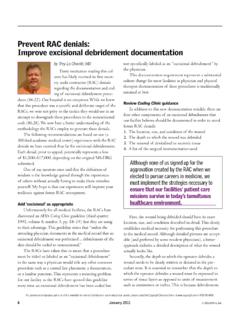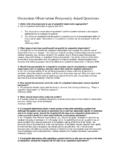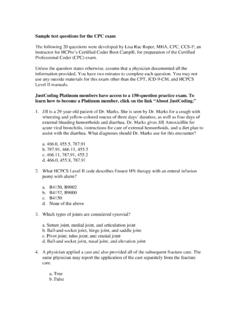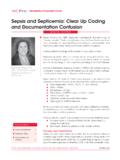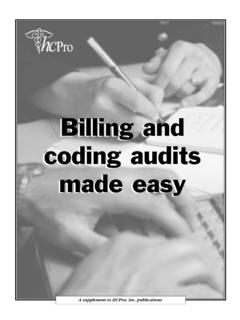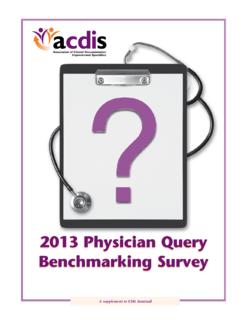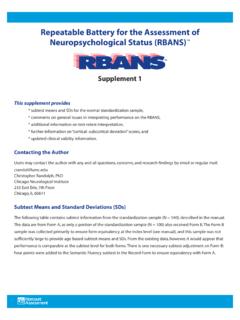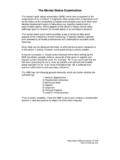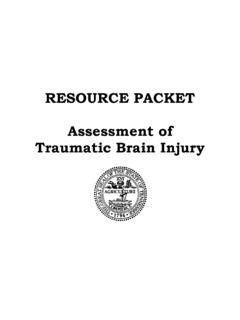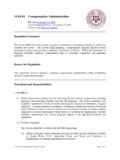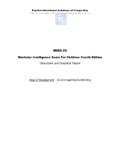Transcription of Medicare Part A billing: How to code the UB-04
1 A supplement to billing Alert for Long-Term CareStatement covers period: UB-04 field 6 The statement period includes the beginning and ending dates for the bill period, usually the calendar month. The through date can be confusing. When the resident leaves the facility, the day of discharge is used. The day of discharge is not paid by Medicare and is the first noncovered day. However, when the resi-dent is taken off Medicare and remains in the facil-ity, the last covered day is entered as the through status: UB-04 field 17 Ultimately, the type of bill drives the patient sta-tus, says Mary Marshall, PhD, president of Manage-ment & Planning Services, Inc., in Fernandina Beach, FL.
2 SNF bill-ers must en-sure that the patient status code is appropriate for the type of bill. Otherwise, the claim will be rejected. The most commonly used patient status code for SNFs is 30, indicating that the resident still remains in the facility. This code must appear on bill types 212 and status for bill types 211 and 214 frequently include one of the following:01 Discharged to home or self-care02 Discharged/transferred to a short-term general hospital for inpatient care20 ExpiredThere are also several additional codes that can be used ( , 03, 04, 06, and 07).Condition codes: UB-04 fields 18 28 Condition codes identify provisions and certain circumstances, such as billing for denial or medical Ultimately, the type of bill drives the patient status.
3 Mary Marshall, PhD Medicare part A billing : How to code the UB-04 billing Medicare part A for SNF services is a game of numbers, but, believe it or not, the digits of inter-est are not dollar amounts; they are codes. SNF billers work with hundreds of diagnosis and procedure codes, known as ICD-9-CM, HCPCS, and CPT codes. Given the sheer volume of these codes, memorization is impossible. However, there are other codes billers should master, such as those on the UB-04 billing form. part A claims contain several types of codes that help tell the fiscal intermediary (FI) or Medicare administrative contractor (MAC) the story of a resi-dent s treatment. For claims to be accurate, certain data must be sent with each claim.
4 The requirements for a given claim depend on the type of bill and the issues that occurred during that billing cycle. In this report, we will discuss certain claim fields used on the UB-04 as they appear on the printed form, rather than how the information is submitted to the FI or MAC electronically, using the 837 format. To view the printed UB-04 form, see p. of bill: UB-04 field 4 The type of bill is a four-digit code in which the first digit, a leading zero, is dropped. The second digit identifies the type of facility submitting a claim. For SNFs, that digit will always be 2. The next digit classi-fies the type of care and will always be 1 for inpatient part A claims.
5 The last digit denotes the sequence of the claim and, for part A claims, could be one of the following:0 No-pay claim1 Admit through discharge claim2 Interim claim (first in the series)3 Interim claim (continuing claim)4 Interim claim (last in the series)7 Replacement of a previous claim; adjustment claim8 Cancellation of a previous claim> continued on p. 2 Medicare part A billing : How to code the UB-042 All occurrence codes have a date, and occurrence code 22 needs to be accompanied by the last covered day, Marshall says. This date correlates to the through date in the statement covers span code and dates: UB-04 fields 35 and 36 Occurrence span codes indicate events that occurred over time and affect payment, such as a qualifying three-day hospital stay.
6 Two common occurrence span codes used on part A SNF claims are:70 Qualifying three-day hospital stay dates. If the resi-dent has more than one hospital stay, use the most current hospital stay dates. Be sure there are three days, not including the day of SNF prior-stay dates. Use this code to connect the qualifying three-day hospital stay dates to a previ-ous SNF 78 occurrence span code and dates are com-monly used when a resident is cut from part A services because of a change in the required level of care but re-quires skilled care within 30 days because of a decline in long as the next skilled stay is within the 30-day window, the Medicare coverage can continue without another three-day qualifying hospital stay.
7 This needs to be used in conjunction with condition code 78 occurrence span code and dates are also used when a resident is discharged from one SNF during a part A stay and readmitted to another SNF without a hospital stay in between. As long as the transfer is made within 30 days of the last covered part A day, the Medi-care coverage can continue without another three-day qualifying hospital codes and amounts: UB-04 fields 39 41A few common value codes used on part A SNF claims are:80 Covered days. Report the number of days covered by Medicare part , with a particular bill. Some commonly used condition codes and the conditions they indicate are:20 Beneficiary requested billing .
8 Used to identify the claim as a beneficiary and/or responsible party claim ( , a demand bill).21 billing for denial notice. Used to trigger a denial notice when services drop to a noncovered level or are excluded by Medicare in order to bill another Medical appropriateness. Used to override the ed-it that denies a claim because the service dates are more than 30 days past the qualifying hospital stay and the delayed services were predictable at the time of SNF readmission. Must be used in conjunction with occurrence span code 78 to indicate prior SNF days when admission is within 30 days of discharge from Medicare but more than 30 days from the qualify-ing hospital Identifies a claim submitted for a beneficiary who is covered by a Medicare Advantage plan that was terminated after he or she was admitted to the SNF.
9 This will bypass the edit for the three-day qualifying hospital the Quality Indicator Organization (QIO) per-forms an expedited review, the biller must select the appropriate QIO indicator code (C3, C4, C7) to report the QIO codes: UB-04 fields 31 34 Occurrence codes indicate specific events that are connected with the claim and could affect processing and payment, such as the last day of skilled occurrence codes required for SNFs are used for Medicare part B claims. However, occurrence code 22, which indicates the last day of skilled care, is used on part A claims when a resident was discharged from Medicare but remains in the facility under a non-Medi-care level of care.
10 How to code the UB-04 < continued from p. 1 March 20093A separate line should be used for each assessment billed on the claim, and each line should contain rev-enue code field also identifies the accommodation rate, which is the rate charged for the room being occupied by the part A resident. It will correspond with the revenue code for room and board of 12X, 13X, or dates: UB-04 field 45 This field is used to identify the MDS assessment ref-erence date for the corresponding HIPPS code . A sepa-rate line should be used for each assessment that was prepared for the units: UB-04 field 46 This field is used to report the number of days that correspond to the appropriate HIPPS code .
